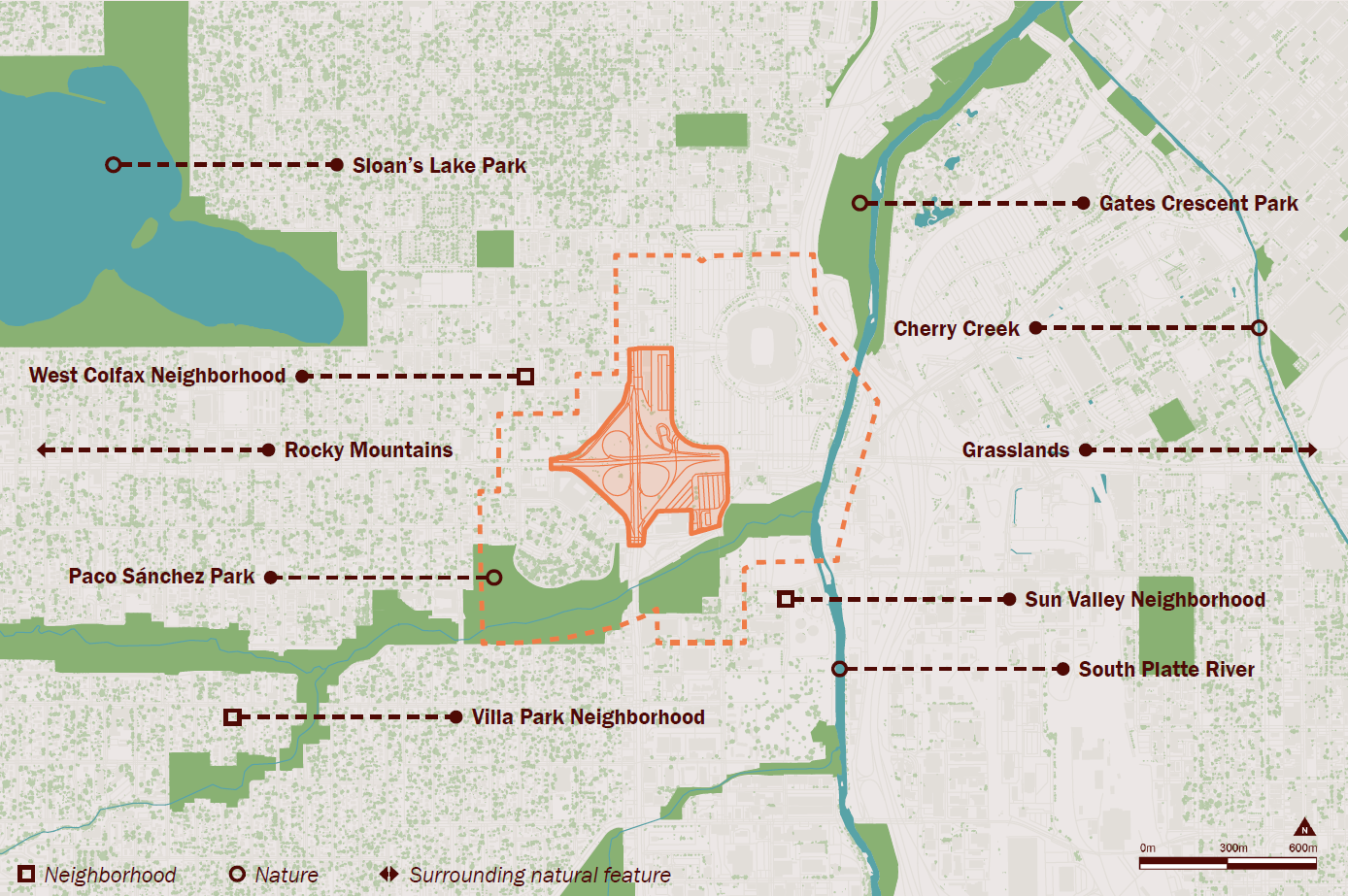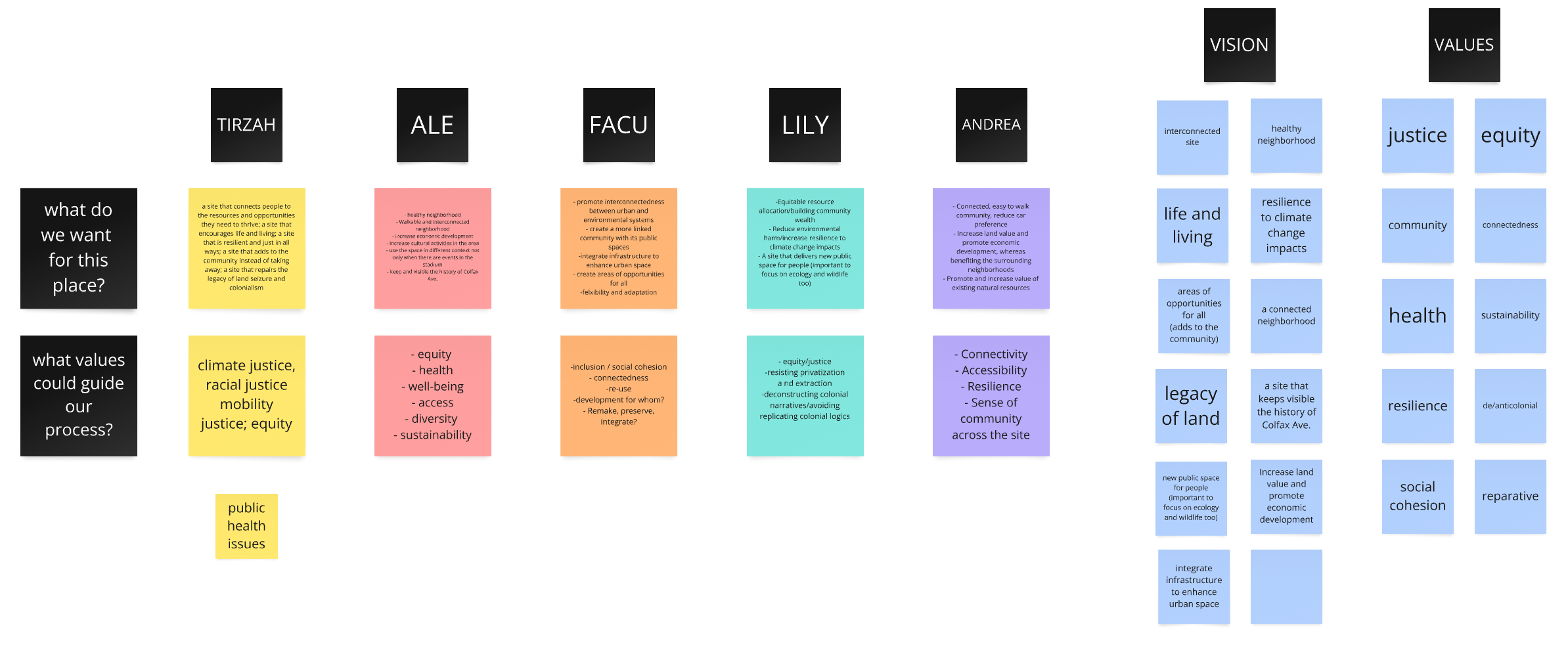The People's Corridor
Returning the cloverleaf to the community
APA student planning competition submission in Denver, CO
Team members: Alessandra Rodriguez Mercado, Andrea Díaz Ferreyra, Facundo Soraire & Lily Moodey
From 12/2024 to 1/2025
Denver's Colfax-Federal interchange, a sprawling, car-dominated piece of infrastructure, has long been a barrier to the surrounding communities, isolating neighborhoods and hindering safe mobility for pedestrians and cyclists. With multiple uncontrolled crossings and high-speed traffic, the interchange has been the site of numerous pedestrian fatalities, underscoring the dangerous conditions for those who live in the area. Despite its proximity to key cultural and community assets—such as vibrant local businesses, historic neighborhoods, and recreational spaces—the area remains underutilized, with a significant lack of green space and essential services. Disinvestment, compounded by high-speed traffic and limited access to transit, has made the area a site of economic and social exclusion.
Our project asks: What if we could transform this space into a community-centered, multimodal hub that prioritizes equity, sustainability, and accessibility? For our APA Planning Student Competition submission, I worked with my team to develop a proposal to redesign the interchange as a public park and mixed-use development that fosters connectivity and well-being for residents.
Context
The Colfax-Federal interchange sits at the intersection of a history shaped by displacement, car-centric development, and ongoing disinvestment. Originally stewarded by Indigenous tribes, the land was transformed by settler colonialism and the rapid expansion of infrastructure, including the streetcar and later, the construction of I-70. This shift toward car-centric development culminated in the demolition of a historic Jewish and Latino neighborhood to make way for a highway cloverleaf. Over the decades, the area has faced declining investment, leaving residents underserved by basic services and surrounded by dangerous, high-speed traffic. Pedestrian fatalities, one as recently as January 2025, highlight the ongoing risks posed by this infrastructure. The city of Denver has identified this interchange as a top priority in its Vision Zero Action Plan to eliminate traffic-related deaths and injuries.
Despite the dangerous conditions and hostile neighborhood context, the site holds great potential, offering views of the Rockies and proximity to transit routes and cultural assets. This presents an opportunity to transform the space into a place that prioritizes people and community over cars.

Natural resources map

Transit conditions map
Goal
Transform the Colfax-Federal interchange into an equitable, vibrant, and sustainable public space that prioritizes community well-being over car infrastructure.
Proposal
The People’s Corridor reimagines the cloverleaf intersection as a public park and mixed-use development, prioritizing pedestrian, cyclist, and public transit accessibility. The proposal envisions a multimodal-friendly environment that integrates green space, affordable housing, and commercial hubs, transforming the interchange from a traffic bottleneck into a community asset.
A key aspect of this transformation is the replacement of the cloverleaf interchange with a more compact, pedestrian-friendly intersection that reduces vehicular dominance. The existing Federal Boulevard bridge will be repurposed as a public overlook featuring green space, enhancing its role as a connector rather than a barrier. At ground level, a network of public plazas and green corridors will create a seamless link between neighborhoods, fostering social interaction and economic vitality. The development will include mixed-use spaces that combine retail, housing, and cultural amenities, ensuring a dynamic and inclusive urban environment.
Transit enhancements play a central role in the redesign, with dedicated bus lanes, expanded bike infrastructure, and improved pedestrian crossings facilitating safe and efficient movement. The project also integrates zoning strategies to mitigate displacement risks, ensuring that the revitalization process benefits existing residents rather than accelerating gentrification. By embedding principles of transit equity and environmental sustainability, The People’s Corridor seeks to reclaim urban space for people, not just cars.
Process
The development of this proposal followed a thoughtful and collaborative approach, integrating a variety of methodologies to ensure it reflected both the historical context of the site and the needs of its current residents. We began by identifying shared values that would ground the development of our vision for the Colfax-Federal interchange transformation. These values—equity, community connectedness, wellbeing, and anti-colonialism and -oppression—formed the foundation for the entire project.

Collaborative brainstorming activity to identify & develop shared values and guiding principles
In this project, my primary role was to integrate research, historical context, and community perspectives into the development of our guiding principles and strategies. I mapped the site’s existing transportation and natural conditions, identifying key opportunities and challenges that would shape the proposal. I also spearheaded the design of the report to reflect our proposal's emphasis on the community: The color palette was inspired by murals and parks near the cloverleaf, emphasizing the connection between local art and the spaces we aimed to transform. I also conceptualized and designed community engagement materials, such as a physical zine and a community events calendar, to communicate our vision in an accessible and compelling way. Though our community engagement was indirect, through research into local forums and news articles, I made sure our proposal remained aligned with the needs and concerns of residents, while providing a comprehensive, actionable framework for the proposed transformation of the Colfax-Federal interchange.
Outcome
The proposal envisions a transformation that reclaims public space from car-centric infrastructure, fostering a dynamic, mixed-use environment that prioritizes community needs. By integrating public transit, affordable housing, and green infrastructure, The People’s Corridor aims to create an equitable and sustainable urban model that can serve as a precedent for other highway-to-public-space transformations.
Look through the full report below: